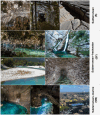Perspectives and pitfalls in preserving subterranean biodiversity through protected areas
- PMID: 39242876
- PMCID: PMC11332058
- DOI: 10.1038/s44185-023-00035-1
Perspectives and pitfalls in preserving subterranean biodiversity through protected areas
Abstract
Subterranean ecosystems (comprising terrestrial, semi-aquatic, and aquatic components) are increasingly threatened by human activities; however, the current network of surface-protected areas is inadequate to safeguard subterranean biodiversity. Establishing protected areas for subterranean ecosystems is challenging. First, there are technical obstacles in mapping three-dimensional ecosystems with uncertain boundaries. Second, the rarity and endemism of subterranean organisms, combined with a scarcity of taxonomists, delays the accumulation of essential biodiversity knowledge. Third, establishing agreements to preserve subterranean ecosystems requires collaboration among multiple actors with often competing interests. This perspective addresses the challenges of preserving subterranean biodiversity through protected areas. Even in the face of uncertainties, we suggest it is both timely and critical to assess general criteria for subterranean biodiversity protection and implement them based on precautionary principles. To this end, we examine the current status of European protected areas and discuss solutions to improve their coverage of subterranean ecosystems.
© 2024. The Author(s).
Conflict of interest statement
The authors declare no competing interests.
Figures


References
-
- Gurney, G. G., Adams, V. M., Álvarez-Romero, J. G. & Claudet, J. Area-based conservation: taking stock and looking ahead. One Earth6, 98–104 (2023).10.1016/j.oneear.2023.01.012 - DOI
-
- Watson, R. T. et al. Post-2020 aspirations for biodiversity. One Earth4, 893–896 (2021).10.1016/j.oneear.2021.07.002 - DOI
Publication types
Grants and funding
- DarCo/Biodiversa+
- DarCo/Biodiversa+
- DarCo/Biodiversa+
- DarCo/Biodiversa+
- DarCo/Biodiversa+
- DarCo/Biodiversa+
- DarCo/Biodiversa+
- DarCo/Biodiversa+
- DarCo/Biodiversa+
- DarCo/Biodiversa+
- DarCo/Biodiversa+
- DarCo/Biodiversa+
- DarCo/Biodiversa+
- DarCo/Biodiversa+
- DarCo/Biodiversa+
- DarCo/Biodiversa+
- DarCo/Biodiversa+
- DarCo/Biodiversa+
- DarCo/Biodiversa+
- DarCo/Biodiversa+
- DarCo/Biodiversa+
- DarCo/Biodiversa+
- DarCo/Biodiversa+
- DarCo/Biodiversa+
- DarCo/Biodiversa+
- DarCo/Biodiversa+
- DarCo/Biodiversa+
- DarCo/Biodiversa+
- DarCo/Biodiversa+
- DarCo/Biodiversa+
- PID2021-124640NB-I00/ERDF "A way of making Europe"
- PID2021-124640NB-I00/ERDF "A way of making Europe"
- PID2021-124640NB-I00/ERDF "A way of making Europe"
- 2022MJSYF8/Ministero dell'Istruzione, dell'Università e della Ricerca
- CN00000033/Ministero dell'Istruzione, dell'Università e della Ricerca
- DL57/2016/CP1375/CT0003/Fundação para a Ciência e a Tecnologia
- DL57/2016/CP1375/CT0003/Fundação para a Ciência e a Tecnologia
- DL57/2016/CP1375/CT0003/Fundação para a Ciência e a Tecnologia
- 101031043/European Commission
LinkOut - more resources
Full Text Sources

